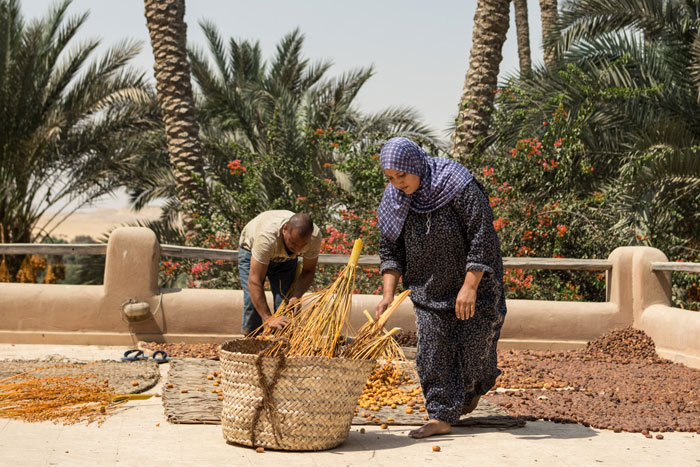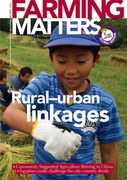The ancient Egyptian civilisation, founded upon the agriculture and peasantry of the Nile Valley, is famous worldwide. Yet, today peasantry in Egypt often denotes poverty and there is a widening social divide between farmers and urban consumers. But over the past ten years, and particularly since the revolution in 2011, Egyptian youth are leading the way in changing the face of Egyptian society. Nawaya is one such initiative that focuses on creating a ‘bridge’ between farming families and Cairo’s city dwellers.

The past ten years have seen rapid change in Egypt as the modern culture of innovation, startups, and green economy has continued to gain ground. Many youth from Cairo have had the opportunity to travel abroad and have on their return, taken an interest in environmental issues, renewable energy and urban farming. NGOs such as Nahdet el Mahrousa, sought alternatives beyond depending on foreign aid development efforts, and supports young innovators achieve their entrepreneurial goals. One notable social enterprise they helped to set up is Nawaya, a group from Cairo working to strengthen rural–urban linkages.
The Nawaya team knew that building stronger links between rural and urban populations in Egypt is a fundamental part of building sustainable farming and food systems. Since the time of the Ottoman rulers, the rift between drivers of agricultural development and the needs of the peasantry has been growing. Today, agricultural holdings have been fragmented, been turned into housing or industrial areas, or sold to big investors. In rural areas, farming is no longer an attractive profession, challenged by inadequate financial and technical support and inaccessible marketing channels. And in urban areas, consumers find it ever more difficult to access high quality, locally produced products. This was the social challenge that Nawaya set out to tackle.
Nawaya
Nawaya is an Arabic play on words meaning ‘fruit stones’ and ‘intentions’, both alluding to improving sustainable agriculture, its central goal. Today, the team has seven members, most of whom are also busy with other work. Sara el Sayed the project manager and curriculum developer, manages an educational travel company, and Ahmed Galal the field coordinator, maintains a popular Facebook page dedicated to changing the way people relate to food.
The group is working on several parallel initiatives including technical aspects of farming with few external inputs, permaculture design, preserving agrobiodiversity, agrotourism, value-adding and product marketing. Importantly, Nawaya is creating a space where the goals and aspirations of both farmers and city dwellers meet.
Green innovation hubs
It was not before the January 25th revolution, 2011, when a real window of opportunity opened for the aspiring youth to take bold steps. And, it was no coincidence that several supportive networks emerged during this period, in which Nawaya was well embedded.
Nawaya not only received technical assistance, legal support, essential training and mentorship from Nahdet el Mahrousa. But the Permaculture Research Institute provided them with experts, trainers and educational material. And the Fagnoon art school, a well established arts centre on the outskirts of Guiza, part of greater Cairo, provided the location for most of their activities, including an experimental plot. Moreover, ICE-Cairo entered the scene, a massively popular meeting point for Cairo’s community interested in solving environmental and social challenges. Nawaya was set up in part by one of ICE-Cairo’s cofounders and until now, ICE-Cairo remains the hub for green innovation.
Farmer field schools
Nawaya developed a curriculum for a farmer field school with funding from Drosos foundation. The curriculum was developed in a participatory way with farmers to ensure that the most relevant topics would be covered. In particular, the field school focused on practices for building soil fertility, pest management and seed production.

Fifteen farmers and their families are currently involved. Those who joined were those willing to experiment on a small part of their own farms (on areas of about 700 m2). Most of the farmers grow wheat, graze cattle, and cultivate various fruits and vegetables, including okra, dates and mangoes.
A key part of the farmer field school approach is learning by doing. Nawaya took over a plot of land in Guiza, within the premises of Fagnoon art school, where they could experiment with permaculture principles alongside the farmers. The soil was highly saline and the available irrigation water was of poor quality, like that of many nearby farmers. The learning process worked both ways, with farmers showing why their traditional techniques worked, and in turn, the Nawaya team showing them how to improve productivity by building up soil fertility with techniques such as composting.
According to one of the farmers, Nawaya’s plot has improved dramatically. No laboratory tests were performed but a change in the soil quality was evident. This motivated the farmers already recruited by Nawaya to continue working with that project, and more farmers from outside the project to know about it. The knowledge generated on Nawaya’s plot and also on farmers’ fields has been documented as success stories for future users, forming part of Nawaya’s educational material in print and film.
Besides experimenting, Nawaya also organises workshops where both producers and consumers participate. For example, a farmer with experience in beekeeping gave a workshop to a group from Cairo. This was empowering for the farmer and is a step towards breaking down social barriers that exist between producers and city dwellers in Egypt. Activities like this help to build trust between growers and the Nawaya team, one of the biggest challenges Nawaya has faced.
From farm to fork
The real chef d’entreprise in any small scale farm is often a woman. This is true worldwide and Egypt is no exception. For this reason, Nawaya also tried to involve as many women as possible. They set up a community kitchen at Fagnoon art school where women could get creative with recipes that add value to what they grow and other local products. Besides providing the kitchen space and assisting with recording recipe development, Nawaya took on the task of packaging and marketing the end products in Cairo.
In early 2014, two Nawaya members, Sara Pozzi and Brendon Johnson, launched the Baladini food brand. They are now selling pasta from the community kitchen at weekly farmers’ markets and shops in Cairo. This initiative has provided an opportunity for women to work outside their homes and to share and learn new skills. Until now, finding a viable business model for this activity has been particularly difficult, and Nawaya is currently exploring how to share the risks and the profits so that the women can reliably generate extra household income.
Consumer consciousness
Nawaya has a growing network including a diverse range of city dwellers that support their activities in different ways. Some of them are well to do consumers interested in the highest quality food products, health conscious consumers supportive of small scale farmers, people interested in the culinary traditions of Egypt, permaculture enthusiasts, chefs, researchers and schools that wish to engage their students in educational gardens.
In total, about 2000 consumers are involved, and the Nawaya Facebook page has received 10,000 likes so far. People buying Nawaya’s produce have particularly enjoyed the traditional white cheese made from grassfed buffalo milk, honey and innovative food items such as caffeine-free coffee made from dates. “Yesterday, in Kattameya market I bought flour from Nawaya. It smells different and reminds me of my childhood,” said Essra, who immediately made bread and looks forward to trying it with the cheese. Now, they aim to reach out for an even bigger market and target middle class consumers. A broader range of products, larger quantities and more exposure might be a way to get more people on board.
Creative network
Much of Nawaya’s success can be attributed to the commitment of their team and their solid local network that has been actively involved from the start. Access to funding at the beginning allowed them to learn by doing, and having space at the Fagnoon art school was particularly helpful to establish themselves as a community. And, working closely with the ICE-Cairo community provided a wealth of creative ideas that helped to find solutions to practical issues. However, it is still challenging to navigate complicated legislations that are not conducive to developing small scale production operations, and accessing specialised knowledge and expertise when needed.
The learning process worked both ways
Nawaya has created a ‘bridge’, where farming families dedicated to reducing external inputs and diversifying their activities meet Cairo’s city dwellers. But this success has not come easily. Perhaps the most important lesson learnt is the importance of risk taking, trial and error, and how to deal with failure constructively. There is still a lot of work ahead as Nawaya plans to further explore the concept of multifunctional farming. They have identified a need for more strategic business planning, more efficient marketing channels, and more involvement from city dwellers. And working on social cohesion and conflict management has become increasingly necessary as they work more with rural communities.
Tarek Soliman
Tarek Soliman has a Masters in agroecology and is a freelance consultant on sustainable food production working with civil society organisations on the right to food. He is currently a fellow of the food innovation program of the Future Food Institute in Bologna, Italy.
Email: tareksoliman143@gmail.com

